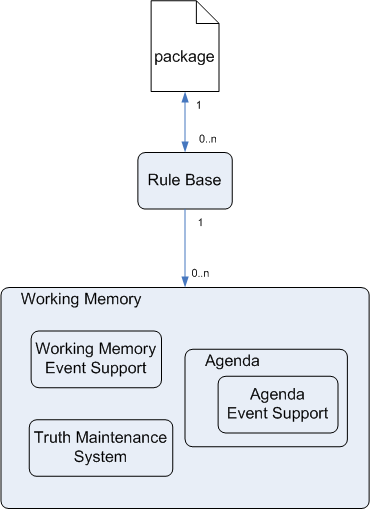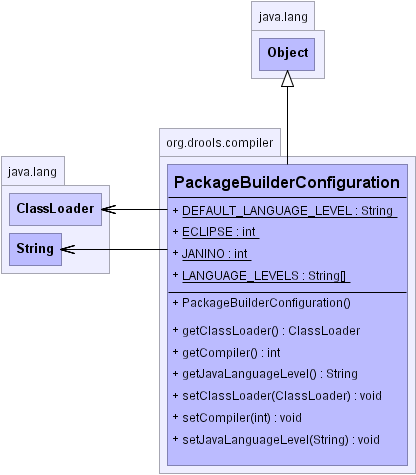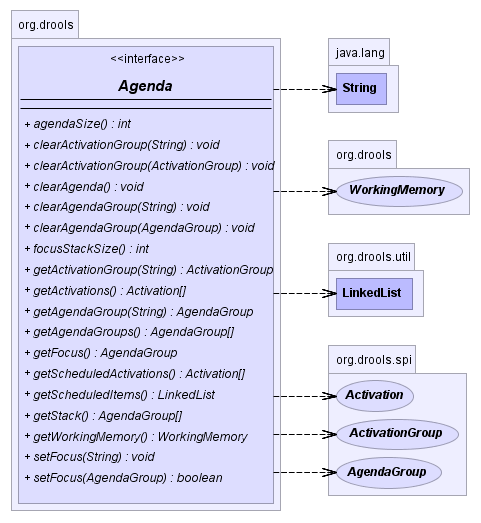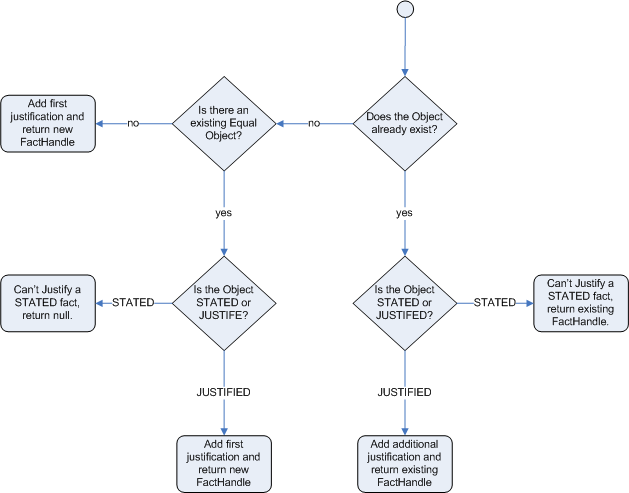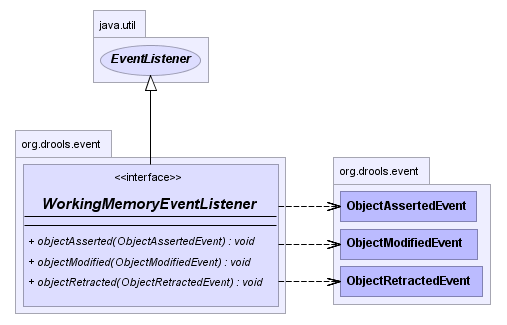1.6. The Drools Rule Engine - JBoss RULES 3.0.6 manual 英文版使用指南文档
Drools is split into two main parts Authoring and Runtime.
The authoring process involves the creation of drl or xml files for rules which are fed into a parser, which is then passed using antlr 3 grammer. The parser checks for correctly formed grammer and produces an intermediate structure for "descr"; where descr indicates the AST "describes" the rules. The AST is then passed to the Package Builder which produces Packages. Package Builder also undertakes any code generation and compilation that is necessary for the creation of the Pacakge. A Packge object is a self contained and deployeable, in that it's serializable, object consisting of one or more rules.
A RuleBase is a runtime component which consists of one or more Package's. Packages can be added and removed from the RuleBase at any time. A Rule Base can instantiate one or more WorkingMemories at any time; a weak reference is maintained, unless it's told otherwise. The Working Memory consists of a number of sub components inculding Working Memory Event Support, Truth Maintenance System, Agenda and Agenda Event Support. Object assertion may result in the creation of one or more Activations, the agenda is resonpsible for scheduling the execution of these Activations.
Three classes are used for authoring DrlParser, XmlParser and PackageBuilder. The two parser classes produce desc AST models from a provided Reader instance. PackageBuilder provides convienience APIs so that you can mostly forget about those classes. The two convienience methods are "addPackageFromDrl" and "addPackageFromXml" - both take an instance of Reader as an argument. The example below shows how to build a package which includes rules from both an xml and drl source which are in the classpath. Note that all added package sources must be of the same package namespace for the current PackageBuilder instance.
Example 1.1. Building a Package from multiple sources
PackageBuilder builder = new PackageBuilder(); builder.addPackageFromDrl( new InputStreamReader( getClass().getResourceAsStream( "package1.drl" ) ) ); builder.addPackageFromXml( new InputStreamReader( getClass().getResourceAsStream( "package2.drl" ) ) ); Package pkg = builder.getPackage();
PackagBuilder is configurable, using PackageBuilderConfiguration. It has default values that can be overriden programmatically via setters or on first use via property settings. Currently it allows alternative compilers (Janino, Eclipse JDT) to be specified, different jdk source levels ("1.4" and "1.5") and a parent class loader. The default compiler is Eclipse JDT Core at source level "1.4" with the parent class loader set to "Thread.currentThread().getContextClassLoader()".
The following show how to specify the JANINO compiler programmatically:
Example 1.2. Configuring the PackageBuilder to use JANINO
PackageBuilderConfiguration conf = new PackageBuilderConfiguration(); conf.setCompiler( PackageBuilderConfiguration.JANINO ); PackageBuilder builder = new PackageBuilder( conf );
This could also be done with a property file setting "drools.compiler=JANINO".
Example 1.3. Configuring the PackageBuilder to build with JDk 1.5 compatability
PackageBuilderConfiguration conf = new PackageBuilderConfiguration(); conf.setJavaLanguageLevel( "1.5" ); PackageBuilder builder = new PackageBuilder( conf );
This could also be done with a property file setting "drools.compiler.languagelevel=1.5".
A Rule Base contains one more more packages of rules, ready to be used (ie they have been validated/compiled etc). A Rule Base is serializable so it can be deployed to JNDI, or other such services. Typically, a rulebase would be generated and cached on first use; to save on the continually re-generation of the Rule Base; which is expensive. A RuleBase is instantiated using the RuleBaseFactory, by default this returns a ReteOO RuleBase. Arguments can be used to specify ReteOO or Leaps. pks are added, in turn, using the addPackage method. You may specify packages of any namespace and multiple packages of the same namespace may be added.
RuleBase ruleBase = RuleBaseFactory.newRuleBase(); ruleBase.addPackage( pkg );
A Rule Base instance is threadsafe, in the sense that you can have the one instance shared accross threads in your application (which may be a web application, for instance). The most common operation on a rulebase is to create a newWorkingMemory.
The Rule Base also holds weak references to any working memories that it has spawned, so if rules are changing (or being added/removed etc) for long running working memories, they can be updated with the latest rules (without necessarily having to restart the working memory). You can specify not to maintain a weak reference, but only do so if you know the Rule Base will not be updated.
ruleBase.newWorkingMemory(); // maintains a weak reference. ruleBase.newWorkingMemory( false ); // do not maintain a weak reference
At any time Packages can be added and removed - all changes will be propated to the existing Working Memories, don't forget to call fireAllRules() for resulting Activations to fire.
ruleBase.addPackage( pkg ); // Add a package instance ruleBase.addPackage( "org.com.sample" ); // remove a package, and all its parts, by it's namespace ruleBase.removeRule( "org.com.sample", "my rule" ); // remove a specific rule from a namespace
While there is a method to remove an indivual rule, there is no method to add an individual rule - to achieve this just add a new packge with a single rule in it.
RuleBaseConfigurator can be used to specify additional behaviour of the RuleBase. RuleBaseConfiguration is set immutable after it has been added to a Rule Base.
RuleBaseConfiguration conf = new RuleBaseConfiguration();
conf.setProperty( RuleBaseConfiguration.PROPERTY_ASSERT_BEHAVIOR,
RuleBaseConfiguration..WM_BEHAVIOR_EQUALITY );
RuleBase ruleBase = new ReteooRuleBase( conf );The two main propertiesto be aware of PROPERT_ASSERT_BEHAVIOR and PROPERTY_LOGICAL_OVERRIDE_BEHAVIOR, which are explain in later sections. All properties and their values are public static field constants on RuleBaseConfiguration.
The Working Memory is the main Class for using the Rule Engine at runtime. It holds references to all data that has been "asserted" into it (until retracted) and it is the place where the interaction with your application occurs. Working memories are stateful objects. They may be shortlived, or longlived. If you are interacting with an engine in a stateless manner, that means you would use the RuleBase object to create a newWorkingMemory for each session, and then discard the working memory when finished (creating a working memory is a cheap operation). An alternative pattern is a working memory that is kept around for a longer time (such as a conversation) - and kept updated with new facts. When you wish to dispose of WorkingMemory it is best pactice to use the dispose() method, so that it removes the reference in the parent Rule Base - however this is a weak reference, so it should eventually me garbage collected anyway. The term Working Memory Action is used to describe assertions, retractions and modifications with the Working Memory.
Facts are objects (beans) from your application that you assert into the working memory. Facts are any java objects which the rules can access. The rule engine does not "clone" facts at all, it is all references/pointers at the end of the day. Facts are your applications data. Strings and other classes without getters and setters are not valid Facts and can't be used with Field Constraints which rely on the JavaBean standard of getters and setters to interact with the object.
"Assertion" is the act of telling the working memory about the facts. WorkingMemory.assertObject(yourObject) for example. When you assert a fact, it is examined for matches against the rules etc. This means ALL of the work is done during assertion; however, no rules are executedl you call "fireAllRules()" after you have finished asserting your facts. This is a common misunderstanding by people who think the work happens when you call "fireAllRules()".
When an Object is asserted it returns a FactHandle. This FactHandle is the token used to represent your asserted Object inside the WorkingMemory, it is also how you will interact with the Working Memory when you wish to retract or modify an object.
Cheese stilton = new Cheese("stilton");
FactHandle stiltonHandle = workingMemory.assertObject( stilton );As mentioned in the Rule Base section a Working Memory may operate in two assertions modes equality and identity - identity is default.
Identity means the Working Memory uses an IdentityHashMap to store all asserted Objects. New instance assertions always result in the return of a new FactHandle, if an instance is asserted twice then it returns the previous fact handle – i.e. it ignores the second assertion for the same fact.
Equality means the Working Memory uses a HashMap to store all asserted Objects. New instance assertions will only return a new FactHandle if a no equal classes have been asserted.
"Retraction" is when you retract a fact from the Working Memory, which means it will no longer track and match that fact, and any rules that are Activated and dependent on that fact will be cancelled. Note that it is possible to have rules that depend on the "non existence" of a fact, in which case retracting a fact may cause a rule to activate (see the 'not' and 'exist' keywords). Retraction is done using the FactHandle that was returned during the assert.
Cheese stilton = new Cheese("stilton");
FactHandle stiltonHandle = workingMemory.assertObject( stilton );
....
workingMemory.retractObject( stiltonHandle );The Rule Engine must be notified of modified Facts, so that it can be re-process. Modification internally is actually a retract and then an assert; so it clears the WorkingMemory and then starts again. Use the modifyObject method to notify the Working Memory of changed objects, for objects that are not able to notify the Working Memory themselves. Notice modifyObject always takes the modified object as a second parameter - this allows you to specify new instances for immutable objects.
Cheese stilton = new Cheese("stilton");
FactHandle stiltonHandle = workingMemory.assertObject( stilton );
....
stilton.setPrice( 100 );
workingMemory.modifyObject( stiltonHandle, stilton );If your fact objects are java beans, you can implement a property change listener for them, and then tell the rule engine about it. This means that the engine will automatically know when a fact has changed, and behave accordingly (you don't need to tell it that it is modified). There are proxy libraries that can help automate this (a future version of drools will bundle some to make it easier). To use the Object in dynamic mode specify true for the second assertObject parameter.
Cheese stilton = new Cheese("stilton");
FactHandle stiltonHandle = workingMemory.assertObject( stilton, true ); //specifies that this is a dynamic factTo make a JavaBean dynamic add a PropertyChangeSupport field memory along with two add/remove mothods and make sure that each setter notifies the PropertyChangeSupport instance of the change.
private final PropertyChangeSupport changes = new PropertyChangeSupport( this );
...
public void addPropertyChangeListener(final PropertyChangeListener l) {
this.changes.addPropertyChangeListener( l );
}
public void removePropertyChangeListener(final PropertyChangeListener l) {
this.changes.removePropertyChangeListener( l );
}
...
public void setState(final String newState) {
String oldState = this.state;
this.state = newState;
this.changes.firePropertyChange( "state",
oldState,
newState );
}Globals are named objects that can be passed in to the rule engine; without needing to assert them. Most often these are used for static information, or services that are used in the RHS of a rule, or perhaps a means to return objects from the rule engine.
new List list = new ArrayList;
workingMemory.setGlobal("list", list);The global definition must be defined in the Rule Base and of the same type, otherwise a runtime exception will be thrown. If a rule evaluates on a global before you set it you will get a NullPointerException.
A shadow fact is a shallow copy of an asserted object. Shadow facts are cached copies of object asserted to the working memory. The term shadow facts is commonly known as a feature of JESS (Java Expert System Shell).
The origins of shadow facts traces back to the concept of truth maintenance. The basic idea is that an expert system should gaurantee the derived conclusions are accurate. A running system may alter a fact during evaluation. When this occurs, the rule engine must know a modification occurred and handle the change appropriately. There's generally two ways to gaurantee truthfullness. The first is to lock all the facts during the inference process. The second is to make a cache copy of an object and force all modifications to go through the rule engine. This way, the changes are processed in an orderly fashion. Shadow facts are particularly important in multi-threaded environments, where an engine is shared by multiple sessions. Without truth maintenance, a system has a difficult time proving the results are accurate. The primary benefit of shadow facts is it makes development easier. When developers are forced to keep track of fact modifications, it can lead to errors, which are difficult to debug. Building a moderately complex system using a rule engine is hard enough without adding the burden of tracking changes to facts and when they should notify the rule engine.
As of Drools 3.0, shadow facts hasn't been implemented, but it is planned for the future. However users can implement this facility themselves if they really need it by building their own proxy implementations.
Rule engines that are based around algorithms like RETE are technically stateful rule engines. That is, they work best when the RETE network is longer lived, being notified of changes, and accumulating facts - that is where they shine.
However, many scenarious simply require a stateless mode where all the facts (data) are supplied fresh to the rule engine and then the rules are invoked. Drools is fine in these scenarious as well - in fact, the RETE algorithm is still of benefit as often there will be scenarios in a stateless session where rules actions cause other rules to fire, or where there are large numbers of facts to match with rules.
The JSR-94 api specifies statefull and stateless modes, but the equivalent in the native API is to simply create a new working memory instance, and then discard it when the session is finished.
The Agenda is a RETE feature. During a Working Memory Action rules may become fully matched and legible for execution; a single Working Memory Action can result in multiple legible rules. When a rule is fully matched an Activation is created, referencing the Rule and the matched facts, and placed onto the Agenda. The Agenda controls the execution order of these Activations using a Conflict Resolution strategy.
The engine operates in a "2 phase" mode which is recursive:
Working Memory Actions - this is where most of the work takes place - in either the Consequence or the main java application process. Once the Consequence has finished or the main java application process calls fireAllRules() the engine switcesh to Agenda Evaluation phase.
Agenda Evaluation - attempts to select a rule to fire, if a rule is not found it exits otherwise it attempts to fire the rule switching the phase back to Working Memory Actions and the process begins again until the Agenda is empty.
The process recurses until the agenda is clear, in which case control returns to the calling application. When Working Memory Actions are taking place, no rules are being fired.
Conflict resolution is required when there are mutliple rules on the agenda. As firing a rule may have side effects on working memory, the rule engine needs to know in what order the rules should fire (for instance, firing ruleA may cause ruleB to be removed from the agenda).
The conflict resolution strategies emplyed by Drools are: Salience and LIFO (last in, first out).
The most visible one is "salience" or priority, in which case a user can specify that a certain rule has a higher priority (by giving it a higher number) then other rules. In that case, the higher salience rule will always be preferred. LIFO priorities based on the assigned Working Memory Action counter value, multiple rules created from the same action have the same value - execution of these are considered arbitrary.
As a general rule, it is a good idea not to count on the rules firing in any particular order, and try and author the rules without worrying about a "flow".
Agenda groups are a way to partition rules (activations, actually) on the agenda. At any one time, only one group has "focus" which means that the activations for rules in that group will only take effect - you can also have rules "auto focus" which means the focus for its agenda group is taken when that rules conditions are true.
They are sometimes known as "modules" in CLIPS terminology. Agenda groups are a handy way to create a "flow" between grouped rules. You can switch the group which has focus either from within the rule engine, or from the API. If you rules have a clear need for multiple "phases" or "sequences" of processing, consider using agenda-groups for this purpose.
Each time setFocus(...) is called it pushes that Agenda Group onto a stack, when the focus group is empty it is popped off and the next one of the stack evaluates. An Agenda Group can appear in multiple locations on the stack. The default Agenda Group is "MAIN", all rules which do not specify an Agenda Group are placed there, it is also always the first group on the Stack and given focus as default.
An example may make things clearer. Imagine a credit card processing application, processing transactions for a given account (and we have a working memory accumulating knowledge about a single accounts transaction). The rule engine is doing its best to decide if transactions are possibly fraudulent or not. Imagine this rule base basically has rules that kick in when there is "reason to be suspicious" and when "everything is normal".
Of course there are many rules that operate no matter what (performing standard calculations etc). Now there are possibly many reasons as to what could trigger a "reason to be suspicious": someone notifying the bank, a sequence of large transactions, transactions for geographically disparate transactions, or even reports of credit card theft. Rather then smattering all the little conditions in lots of rules, imagine there is a fact class called "SuspiciousAccount".
Then there can be a series of rules whose job is to look for things that may raise suspicion, and if they fire, they simply assert a new SuspiciousAccount() instance. All the other rules just have conditions like "not SuspiciousAccount()" or "SuspiciousAccount()" depending on their needs. Note that this has the advantage of allowing there to be many rules around raising suspicion, without touching the other rules. When the facts causing the SuspiciousAccount() assertion are removed, the rule engine reverts back to the normal "mode" of operation (and for instance, a rule with "not SuspiciousAccount()" may kick in which flushes through any interrupted transactions).
If you have followed this far, you will note that truth maintenance like logical assertions allows rules to behave a little like a human would, and can certainly make the rules more managable.
Filters are optional implementations of a the filter interface which are used to allow/or deny an activation from firing (what you filter on, is entirely up to the implementation). Drools provides the following convienience default implementations
RuleNameEndWithAgendaFilter
RuleNameEqualsAgendaFilter
RuleNameStartsWithAgendaFilter
To use a filter specify it while calling FireAllRules. The following example will filter out all rules ending with the text "Test":
workingMemory.fireAllRules( new RuleNameEndsWithAgendaFilter( "Test" ) );
In a regular assertion, you need to explicitly retract a fact. With logical assertions, the fact that was asserted will be automatically retracted when the conditions that asserted it in the first place are no longer true (its actually cleverer then this, if there are no possible conditions that could support the logical assertion, only then will it be retracted).
Normal assertions are said to be “STATED” (ie The Fact has been stated - just like the intuitive concept). Using a HashMap and a counter we track how many times a particuarly equality is STATED; this means we count how many different instances are equal. When we logical assert an object we are said to justify it and it is justified by the firing rule.For each logical assertion there can only be one equal object, each subsequent equal logical assertion increases the justification counter for this logical assretion. As each justification is removed when we have no more justifications the logical object is automatically retracted. If we logically assert an object when there is an equal STATED object it will fail and return null. If we STATE an object that has an exist equal object that is JUSTIFIED we override the Fact - how this override works depends on the configuration setting "WM_BEHAVIOR_PRESERVE". When the property is set to discard we use the existing handle and replace the existing instance with the new Object - this is the default behaviour - otherwise we overrde it to STATED but we create an new FactHandle.
This can sound confusing on a first read, so hopefully the flow charts below help. When it says that it returns a new FactHandle, this also indecates the Object was propagated through the network.
The event package provides means to be notified of rule engine events, including rules firing, objects being asserted etc. This allows you to seperate out logging/auditing activities from the main part of your application (and the rules) - as events are a cross cutting concern.
There are two types of event listeners - WorkingMemoryEventListener and AgendEventListener.
Both EventListeners have default implementations that implement each method, but do nothing, these are convienience classes that you can inherit from to save having to implement each method - DefaultAgendaEventListener and DefaultWorkingMemoryEventListener. The following showd how to extend DefaultAgendaEventListener and add it to the Working Memory - the example prints statements for only when rules are fired:
workingMemory.addEventListener( new DefaultAgendaEventListener() {
public void afterActivationFired(AfterActivationFiredEvent event) {
super.afterActivationFired( event );
System.out.println( event );
}
});Drools also provides DebugWorkingMemoryEventListener and DebugAgendaEventListener that implements each method with a debug print statement:
workingMemory.addEventListener( new DebugWorkingMemoryEventListener() );
The Eclipse based Rule IDE also provides an audit logger, and graphical viewer, so that the rule engine can log events for later viewing, and auditing.


